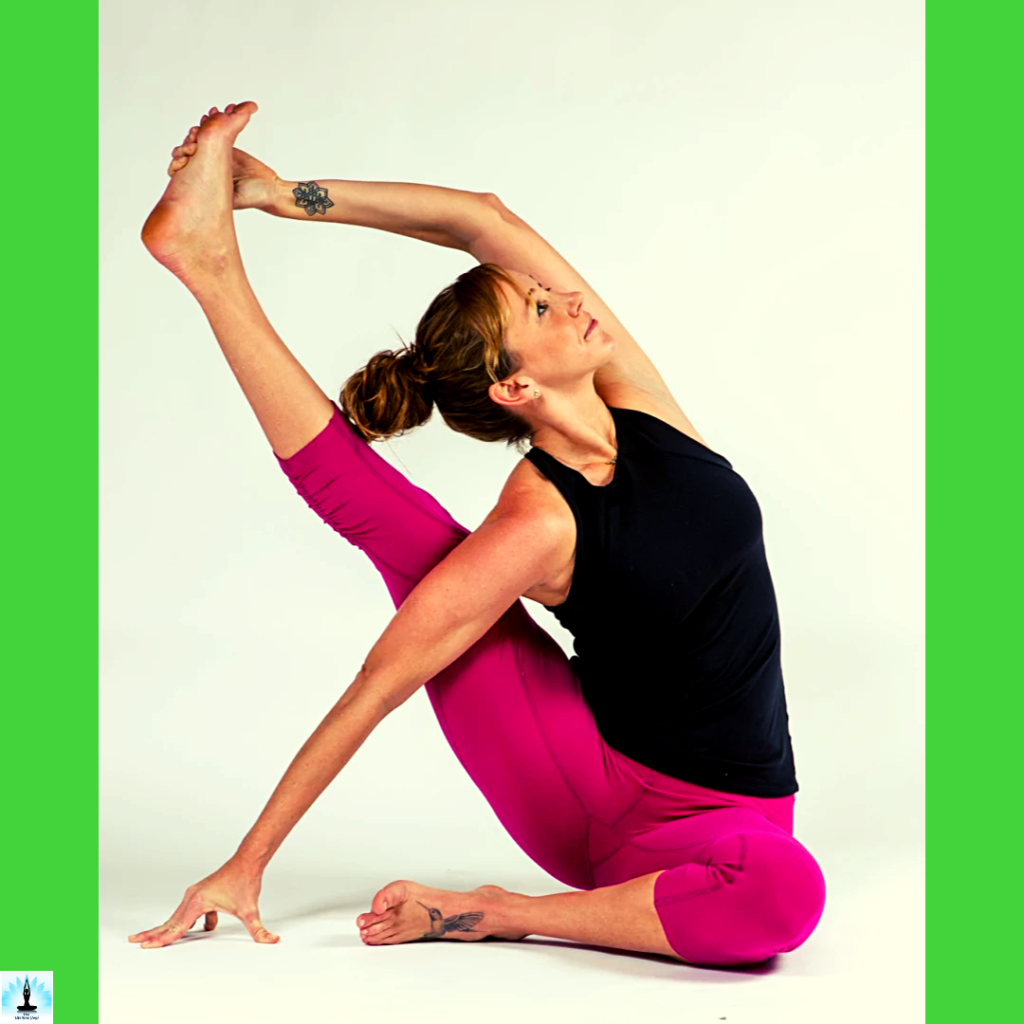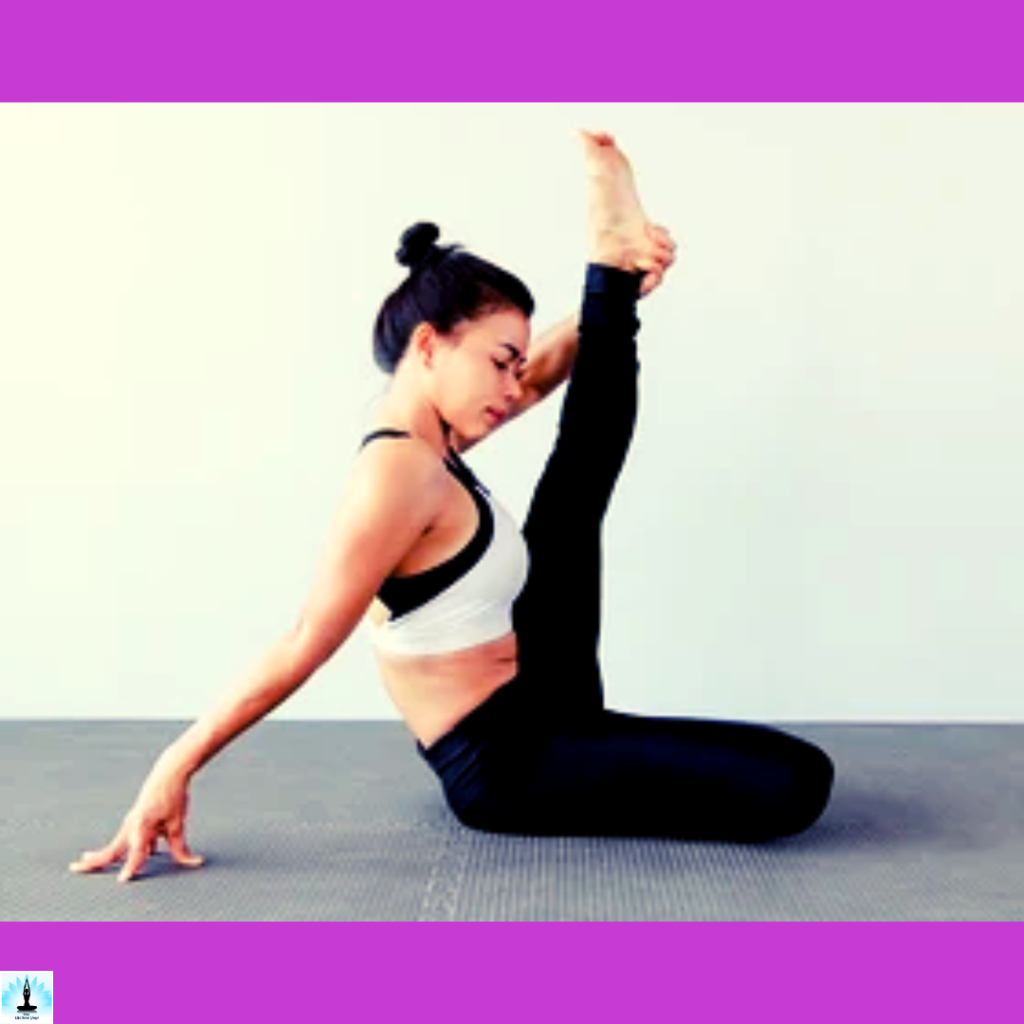Introduction – 9 Top Benefits of Kraunchasana | How to Perform Kraunchasana?
Kraunchasana, also known as Heron Pose, is a yoga asana that derives its name from the Sanskrit word “krauncha,” which translates to “heron” or “crane.” This pose emulates the elegant and poised stance of a heron wading in water, reflecting both grace and balance. In Kraunchasana, practitioners sit on the floor, extending one leg straight while bending the other leg and drawing the heel toward the pelvis.
Table of Contents
The Yogic Philosophy of The Kraunchasana

Kraunchasana, or Heron Pose, embodies the yogic philosophy by symbolizing the qualities of balance, poise, and focused awareness. The pose draws inspiration from the graceful heron, reflecting the harmonious integration of strength and elegance. As practitioners engage in the deliberate movements and balance challenges of Kraunchasana, they are encouraged to cultivate mindfulness, fostering a connection between the physical body and the tranquil qualities of the mind.
Which Chakra is Activated by Practicing Kraunchasana?
Located in the lower abdomen, the Svadhisthana Chakra is associated with creativity, sensuality, and emotional well-being. Kraunchasana, with its focus on the lower back, hips, and pelvis, stimulates and balances the energy in this chakra. The dynamic engagement of the pelvic region in the pose is believed to enhance the flow of vital energy within the Svadhisthana Chakra, promoting a sense of emotional fluidity, creativity, and a harmonious connection with one’s sensuous aspects of life.
Top Benefits of Kraunchasana

Improved Flexibility:
Kraunchasana targets the hamstrings, quadriceps, and lower back, promoting increased flexibility in these muscle groups.
Strengthens Leg Muscles:
The pose engages the muscles in the legs, particularly the quadriceps, promoting strength and toning.
Enhanced Balance and Stability:
Kraunchasana challenges balance as practitioners lift one leg off the ground, fostering improved stability and concentration.
Stimulates Svadhisthana Chakra:
The pose activates the Svadhisthana Chakra, promoting a harmonious flow of energy associated with creativity, sensuality, and emotional well-being.
Tones Abdominal Muscles:
Engaging the core in Kraunchasana contributes to abdominal strength and toning, promoting a more stable and supportive core.
Stimulates Digestive Organs:
The compression and stretching involved in Kraunchasana stimulate the digestive organs, potentially aiding in digestion and promoting abdominal health.
Improves Posture:
Regular practice of Kraunchasana encourages an upright and aligned posture, contributing to overall spinal health.
Alleviates Mild Back Pain:
The gentle stretch and strengthening of the lower back muscles in Kraunchasana may provide relief from mild back pain and discomfort.
Stimulates Blood Circulation:
The dynamic nature of the pose encourages improved blood circulation, benefiting the entire lower body and promoting cardiovascular health.
How to Perform Kraunchasana? | Step-by-Step Instructions of Kraunchasana

Starting Position:
Begin in a seated position with your legs extended in front of you.
Bend One Knee:
Bend your right knee and bring the foot towards the pelvis, placing the sole of the foot on the inner thigh.
Straighten the Leg:
Extend your left leg straight in front of you, keeping the foot flexed.
Hold the Foot:
Reach forward with both hands to hold the left foot. You can use a yoga strap or belt if reaching the foot is challenging.
Straighten the Spine:
Lengthen your spine, lifting your chest and rolling your shoulders back. Keep your gaze forward.
Engage the Core:
Engage your core muscles to maintain stability. This also supports the lower back.
Lift the Leg:
As you exhale, lift your left leg off the ground, keeping it straight. Maintain a slight bend in the knee if needed.
Hold and Breathe:
Hold the lifted position for a few breaths, focusing on balance and extending through the lifted leg.
Release and Switch Sides:
Gently release the lifted leg back to the floor and switch sides, repeating the steps with the opposite leg.
Ensure Alignment:
Check that your hips remain level and squared to the front. The extended leg should be in line with your hip.
Maintain a Steady Breath:
Throughout the pose, maintain a steady and controlled breath. Avoid holding your breath.
Exit the Pose Mindfully:
To release, lower the lifted leg to the floor and return to a seated position. Take a moment to observe the effects of the pose.
Advanced Variations of Kraunchasana
Parivrtta Kraunchasana (Revolved Heron Pose):

In this advanced variation, practitioners add a twist to Kraunchasana by rotating the torso towards the bent knee. The twist deepens the stretch in the spine, increases the challenge to the core muscles, and further enhances the pose’s overall complexity.
Eka Pada Kraunchasana (One-Legged Heron Pose):

Eka Pada Kraunchasana involves extending one leg straight while holding the other leg in a bent position, resembling a one-legged variation of Kraunchasana. This variation intensifies the stretch in the extended leg and requires increased strength and balance in the supporting leg, adding an advanced element to the pose.
Therapeutic Applications of Kraunchasana
Kraunchasana offers therapeutic benefits by stretching and strengthening various muscle groups. The pose targets the hamstrings, quadriceps, and lower back, promoting improved flexibility and mobility in these areas. Additionally, Kraunchasana engages the core muscles, contributing to abdominal strength and stability.
Poses Related to Kraunchasana (Heron Pose)
Preparatory Poses of Kraunchasana
Baddha Konasana (Bound Angle Pose):

Baddha Konasana, or Bound Angle Pose, is an excellent preparatory pose for Kraunchasana as it opens the hips and stretches the inner thighs. The seated position of Baddha Konasana helps warm up the pelvic region, preparing the body for the hip engagement in Kraunchasana.
Paschimottanasana (Seated Forward Bend):

Paschimottanasana serves as a beneficial precursor to Kraunchasana by stretching the entire posterior chain, including the hamstrings and lower back. The forward bend motion also prepares the spine for the extension and balance required in Kraunchasana.
Follow-up Poses of Kraunchasana
Marichyasana III (Marichi’s Pose III):

Following Kraunchasana, Marichyasana III offers a seated twist that complements the backbend and balance aspects of Kraunchasana. It further engages the core and promotes spinal flexibility, providing a well-rounded sequence.
Virasana (Hero Pose):

Virasana is a suitable pose to practice after Kraunchasana as it allows the body to come back to a neutral seated position. Virasana stretches the thighs, ankles, and knees, providing a counterbalance to the dynamic hip engagement in Kraunchasana.
Beginner’s Tip of Kraunchasana (Heron Pose)
For beginners exploring Kraunchasana, it is essential to prioritize proper alignment and gradual progression. Start by sitting comfortably and warming up the body with gentle stretches, particularly focusing on the hamstrings and lower back. When lifting the extended leg, keep a slight bend in the knee if necessary, gradually working towards straightening the leg over time. Utilize props such as blocks or a strap to assist in reaching the foot, especially for those with limited flexibility.
Contraindications and Cautions of Kraunchasana (Heron Pose)
Those with knee, hip, or lower back injuries should consult with a healthcare professional or yoga instructor before attempting Kraunchasana. Pregnant women are advised to avoid deep forward bends and should modify the pose accordingly. Individuals with ankle issues or recent surgeries should be mindful of the foot’s position during the pose.
FAQ’s on Kraunchasana (Heron Pose)
Q: Can Beginners Practice Kraunchasana?
A: Kraunchasana is an intermediate to advanced yoga pose that involves a combination of balance, flexibility, and strength. Beginners are encouraged to approach the pose gradually, starting with preparatory poses and seeking guidance from an experienced yoga instructor.
Q: How Can I Improve My Balance in Kraunchasana?
A: Improving balance in Kraunchasana involves regular practice and developing core strength. Focus on a steady gaze, engage the core muscles, and use a wall or a prop for support until balance is strengthened.
Q: Are There Modifications for Individuals with Tight Hamstrings?
A: Yes, individuals with tight hamstrings can use props like a yoga strap to reach the foot in Kraunchasana. Keeping a slight bend in the extended leg is also a modification that helps accommodate limited hamstring flexibility.
Q: Is Kraunchasana Safe for Individuals with Lower Back Issues?
A: Individuals with lower back issues should approach Kraunchasana with caution. Consulting with a healthcare professional or a qualified yoga instructor is advisable to assess whether modifications or alternative poses are needed.
Q: Can Kraunchasana Be Practiced During Pregnancy?
A: Pregnant women should avoid deep forward bends, and Kraunchasana may not be suitable during pregnancy. It is recommended to consult with a healthcare provider or a prenatal yoga instructor for appropriate modifications or alternative poses.
Q: How Does Kraunchasana Benefit the Hips?
A: Kraunchasana engages the hips by stretching the hip flexors and opening the front of the hip on the extended leg side. The pose also requires active hip flexion in the bent leg, contributing to overall hip flexibility.
Q: Can Kraunchasana Help in Relieving Sciatica Pain?
A: Kraunchasana may provide relief for some individuals with sciatica by stretching the hamstrings and engaging the core. However, those with sciatica or other back issues should approach the pose cautiously and seek guidance from a healthcare professional.
Q: How Long Should One Hold Kraunchasana?
A: The duration of holding Kraunchasana can vary. Beginners may start with a few breaths and gradually work up to holding the pose for 30 seconds to a minute on each side. It is essential to listen to the body and avoid overexertion.
Q: Can Kraunchasana Be Part of a Daily Yoga Practice?
A: Kraunchasana can be part of a daily yoga practice for experienced practitioners who have developed the necessary strength and flexibility. However, it is essential to balance the practice with other poses and listen to the body’s feedback.
Q: What Is the Mental Focus During Kraunchasana?
A: Mental focus during Kraunchasana involves concentration on balance, breath awareness, and maintaining a calm and focused mind. Practitioners are encouraged to cultivate mindfulness and observe sensations in the body during the pose.
Conclusion
In conclusion, Kraunchasana, or Heron Pose, stands as a dynamic expression of balance, strength, and flexibility within the realm of yoga. Named after the elegant heron, this asana invites practitioners to emulate the bird’s poise and grace while navigating the challenges of a seated balance and deep hamstring stretch. Kraunchasana serves as a bridge between seated and balancing poses, requiring a harmonious interplay of body and mind.
References
- Mehta, Silva; Mehta, Mira; Mehta, Shyam (1990). Yoga: The Iyengar Way. London: Dorling Kindersley. p. 62.
- Iyengar, B. K. S. (1979) [1966]. Light on Yoga. Schocken Books. pp. 158–159.
- Iyengar, B. K. S. (1979) [1966]. Light on Yoga. Schocken Books. p. 523.
- Sinha, S.C. (1996). Dictionary of Philosophy. Anmol Publications. p. 18. ISBN 978-81-7041-293-9.
- Sjoman, Norman E. (1999). The Yoga Tradition of the Mysore Palace. Abhinav Publications. pp. 44, 50, 79, 91. ISBN 81-7017-389-2
